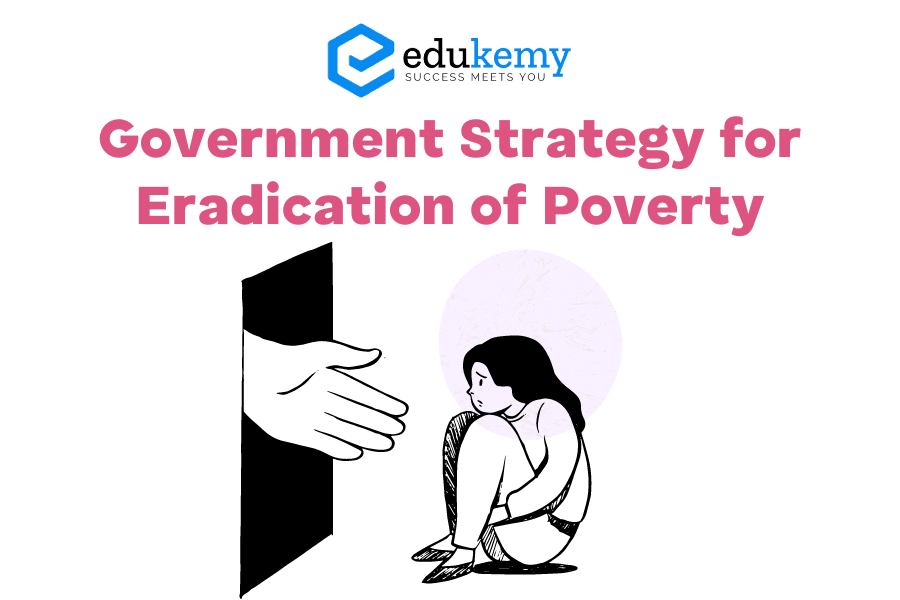
The eradication of poverty is a multifaceted challenge that requires a comprehensive strategy. The Indian government has adopted various measures to address poverty, focusing on economic growth, social welfare, and targeted anti-poverty programs. Here are key elements of the government’s strategy:
- Economic Growth:
- Emphasizes that the growth of the economy is the primary driver of poverty eradication. Economic development creates job opportunities and improves living standards.
- Focus on MSMEs (Micro, Small, and Medium Enterprises):
- Government interventions are directed toward promoting Micro, Small, and Medium Enterprises (MSMEs) to ensure inclusive growth. MSMEs play a crucial role in generating employment and fostering economic development.
- Welfare State Initiatives:
- Implementation of welfare state policies, such as the National Food Security Act (NFSA) 2013, to ensure food security for all citizens.
- Energy Security Schemes:
- Initiatives like Saubhagya and Ujjwala to enhance energy security, ensuring access to electricity and clean cooking fuel for households.
- Old Age Security:
- Schemes like the Pradhan Mantri Shram Yogi Maan-dhan (PMSYM) to ensure old-age security for workers in the unorganized sector.
- Anti-Poverty Programs:
- Implementation of targeted anti-poverty programs like Pradhan Mantri Awas Yojana (PMAY) and Deendayal Antyodaya Yojana (DAY) to provide housing and improve the well-being of vulnerable populations.
- Decentralization through PRIs and Nagarapalikas:
- Promotion of decentralization through Panchayati Raj Institutions (PRIs) and Nagarapalikas (Urban Local Bodies) for more effective and localized delivery models of development programs.
- Multidimensional Poverty Index (MPI):
- According to the 2018 Multidimensional Poverty Index (MPI) by the Oxford Poverty and Human Development Initiative (OPHI), approximately 271 million people were lifted out of poverty in India between 2005-2006 and 2015-2016. The poverty rate declined from 55% to 28%, almost halving during this period.
The government’s approach combines economic development, social welfare, and targeted interventions to address the complex challenges associated with poverty. Monitoring and evaluation through indices like the MPI provide insights into the progress made and areas that need further attention.
Contents
- 1 FAQs
- 1.1 Q: What is the government’s strategy for eradicating poverty?
- 1.2 Q: How does the government identify and prioritize areas for poverty eradication?
- 1.3 Q: What role do public-private partnerships play in the government’s poverty eradication strategy?
- 1.4 Q: How does the government ensure accountability and transparency in poverty eradication efforts?
- 1.5 Q: What long-term strategies does the government have in place to sustain poverty eradication efforts?
- 2 In case you still have your doubts, contact us on 9811333901.
FAQs
Q: What is the government’s strategy for eradicating poverty?
The government’s strategy for eradicating poverty involves a multi-pronged approach, including social welfare programs, economic empowerment initiatives, and targeted interventions. These programs aim to provide access to basic necessities such as food, healthcare, education, and housing, while also creating opportunities for sustainable livelihoods and income generation.
Q: How does the government identify and prioritize areas for poverty eradication?
The government employs various tools and metrics to identify areas with high levels of poverty, including income inequality indices, demographic data, and socio-economic surveys. Priority is given to regions and communities with the greatest need, often characterized by low human development indicators, lack of infrastructure, and limited access to essential services.
Q: What role do public-private partnerships play in the government’s poverty eradication strategy?
Public-private partnerships (PPPs) are integral to the government’s poverty eradication strategy, leveraging the resources and expertise of both sectors to maximize impact. Through PPPs, the government collaborates with businesses, non-profit organizations, and civil society groups to implement innovative solutions, mobilize funding, and scale up interventions in key areas such as job creation, skills development, and social welfare.
Q: How does the government ensure accountability and transparency in poverty eradication efforts?
The government employs mechanisms such as monitoring and evaluation frameworks, independent audits, and public reporting to ensure accountability and transparency in poverty eradication efforts. These mechanisms facilitate oversight, track progress, and identify areas for improvement, while also fostering trust and confidence among stakeholders.
Q: What long-term strategies does the government have in place to sustain poverty eradication efforts?
The government’s long-term strategies for sustaining poverty eradication efforts focus on building resilience, promoting inclusive growth, and addressing structural barriers to development. This includes investments in education, healthcare, infrastructure, and social protection systems, as well as policies that promote equitable access to resources and opportunities for all citizens. Additionally, efforts are made to integrate poverty eradication goals into broader development frameworks and to foster partnerships with international organizations and donor agencies for continued support.
In case you still have your doubts, contact us on 9811333901.
For UPSC Prelims Resources, Click here
For Daily Updates and Study Material:
Join our Telegram Channel – Edukemy for IAS
- 1. Learn through Videos – here
- 2. Be Exam Ready by Practicing Daily MCQs – here
- 3. Daily Newsletter – Get all your Current Affairs Covered – here
- 4. Mains Answer Writing Practice – here

